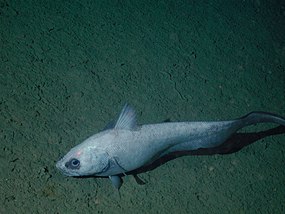Rattails
| Grenadiers | |
|---|---|
 |
|
| Coryphaenoides leptolepis | |
| Scientific classification | |
| Kingdom: | Animalia |
| Phylum: | Chordata |
| Class: | Actinopterygii |
| Order: | Gadiformes |
| Family: |
Macrouridae C. H. Gilbert & C. L. Hubbs, 1916 |
Grenadiers or rattails are generally large, brown to black gadiform marine fish of the family Macrouridae. Found at great depths from the Arctic to Antarctic, members of this family are amongst the most abundant of the deep-sea fish.
The macrourids form a large and diverse family with 28 extant genera recognized (well over half of the total species are contained in just three genera, Coelorinchus, Coryphaenoides, and Nezumia). They range in length from about 10 cm (3.9 in) in Hymenogadus gracilis to 1.5 m (4.9 ft) in Albatrossia pectoralis. An important commercial fishery exists for the larger species, such as the giant grenadier and Coryphaenoides rupestris. The family as a whole may represent up to 15% of the deep-sea fish population.
Typified by large heads with large mouths and eyes, grenadiers have slender bodies that taper greatly to very thin caudal peduncles or tails (excluding one species with no tail fin): this rat-like tail explains the common name 'rattail' and the family name Macrouridae, from the Greek makros meaning "great" and oura meaning "tail". The first dorsal fin is small, high, and pointed (and may be spinous); the second dorsal fin runs along the rest of the back and merges with the tail and extensive anal fin. The scales are small.
As with many deep-living fish, the lateral line system in grenadiers is well-developed; it is further aided by numerous chemoreceptors located on the head and lips and chemosensory barbels underneath the chin. Benthic species have gas bladders with unique muscles attached to them. The animals are thought to use these muscles to "strum" their gas bladders and produce sound, possibly playing a role in courtship and mate location. Light-producing organs, photophores, are present in some species; they are located in the middle of the abdomen, just before the anus and underneath the skin.
...
Wikipedia
